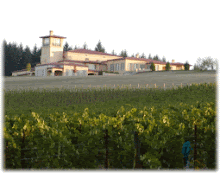 Finally pressed off, we now busy ourselves with racking our settlers off the heavy lees and barreling down. The idea is to be as gentle as possible with the wine at this juncture; we do not use any pumps to transfer the wine into barrel but instead allow the head pressure in the tank to push the liquid down a series of fixed lines into the blending level, a floor below. The flow rate is then controlled by a valve at the barreling wand. This is a function is commonly referred to as "gravity-flow" and results in fresher, less-oxidized wines than when compared to barreling with a pump.
Finally pressed off, we now busy ourselves with racking our settlers off the heavy lees and barreling down. The idea is to be as gentle as possible with the wine at this juncture; we do not use any pumps to transfer the wine into barrel but instead allow the head pressure in the tank to push the liquid down a series of fixed lines into the blending level, a floor below. The flow rate is then controlled by a valve at the barreling wand. This is a function is commonly referred to as "gravity-flow" and results in fresher, less-oxidized wines than when compared to barreling with a pump.Although there is still much work to be done--the majority of the wines from this vintage won't be released for two years--many of the interns will close out their tenure at Domaine Serene by the end of the month. Due to our imminent departure, I think the mood in the cellar has become a little introspective of late, as we attempt to put the past few months in perspective. As I look back on the harvest, I cant help but wonder what it is that drives seemingly normal, sane people to repeatedly commit to such an overwhelming undertaking. Whats more, a harvest is not just the baggage that comes along with making wine, it is unequivocally the highlight of our year. Many of us even go to great pains to participate in two every year.
 Obviously all of us in the cellar are enthralled by wine; we must be interested to an almost absurd degree to devote our lives to it. However, at some point during the harvest, after a month of Mondays, roughly three hundred gallons of coffee, and woefully little sleep, there has to be something else in it besides wine.
Obviously all of us in the cellar are enthralled by wine; we must be interested to an almost absurd degree to devote our lives to it. However, at some point during the harvest, after a month of Mondays, roughly three hundred gallons of coffee, and woefully little sleep, there has to be something else in it besides wine.As best as I can figure, the hidden beauty of a vintage is the suspension of reality that comes with the crush. Only in this mode does it seem perfectly reasonable to run around wearing a camouflage bandanna covered in grape juice, an unruly beard, and terribly unkempt hair in one's workplace. In this "harvest zone" we relinquish the stale names for the days of the week and replace them with different markers: Sunday becomes the day Frank Sinatra serenades the cellar in the morning, Tuesday is dry ice delivery day, and Thursday, the day we feast on tacos for lunch. Furthermore, we will proudly display our harvest hands (blackened semi-permanently from grape juice) to anyone who will cast a passing glance, blissfully unaware that gnarled and beaten-up hands aren't as revered by all.
When, at long last, we finally emerge from this parallel reality back to our normal lives, we are pleasantly surprised to realize that we have participated in something monumental and indelible, at least until many years down the road when the very last bottle of the vintage is uncorked and savored. – Written by Zach Bryant, Harvest Intern. Photos by Megan Jones.







































